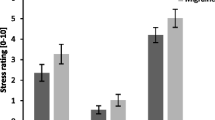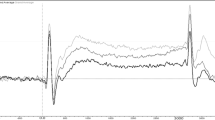Abstract
Subjective stress sensitivity and physiological parameters were compared between 24 migraine subjects and 24 matched headache-free controls during a multifrequency 85-dB (A) aversive auditory Stressor and during a recovery period. Measures consisted of frontalis EMG, temporal artery blood volume pulse, heart rate, a stress sensitivity questionnaire, stress reaction during the stress-expectation period, and ratings of noise aversiveness. Migraine subjects showed a higher level of general stress sensitivity, increased situational stress sensitivity, and higher ratings of noise aversiveness; this supports the general notion that migraine sufferers are psychologically more sensitive toward stress stimulation than nonheadache controls. Physiologically, the migraine subjects differed from the control group only with regard to the temporal blood volume pulse during stress stimulation; this finding is consistent with Wolff's weak-link theory.
Similar content being viewed by others
References
Adams, H. E., Feuerstein, M., and Fowler, J. L. (1980). Migraine headache: Review of parameters, etiology, and intervention.Psychol. Bull. 87: 217–237.
Anderson, C. D., Stoyva, J. M., and Vaughn, L. J. (1982). A test of delayed recovery following stressful stimulation in four psychosomatic disorders.J. Psychosom. Res. 26: 571–580.
Andrasik, F., Blanchard, E. B., Arena, J. G., Saunders, N. L., and Barron, K. D. (1982). Psychophysiology of recurrent headache: Methodological issues and new empirical findings.Behav. Ther. 13: 407–429.
Arena, J. G., Blanchard, E. B., Andrasik, F., Cotch, P. A., and Myers, P. E. (1983). Reliability of psychophysiological assessment.Behav. Res. Ther. 21: 447–460.
Boucsein, E., Erdmann, G., Janke, W., and Albrecht, D. (1978). Der Belastungsfragebogen BELA (the stress questionnaire BELA).Ärztliche Praxis 37: 1172–1178.
Cohen, M. J., Rickles, W. H., and McArthur, D. L. (1978). Evidence for physiological response stereotypy in migraine headache.Psychosom. Med. 40: 344–354.
Cohen, R. A., Williamson, D. A., Monguillot, J. E., Hutchinson, P. C., Gottlieb, J., and Waters, W. F. (1983). Psychophysiological response patterns in vascular and muscle-contraction headaches.J. Behav. Med. 6: 93–107.
Dalsgaard-Nielsen, T. (1965). Migraine and heredity.Acta. Neurol. 41: 287–300.
Drummond, P. D. (1982). Extracranial and cardiovascular reactivity in migrainous subjects.J. Psychosom. Res. 26: 317–331.
Feuerstein, M., Bush, C., and Corbisiero, R. (1982). Stress and chronic headache: A psychophysiological analysis of mechanisms.J. Psychosom. Res. 26: 167–182.
Florin, I., Gerhards, F., Knispel, M., Koch, M., and Bätza-Reinhardt, K. (1982). Subjective and objective stress in migraine patients. Paper presented at the 14th European Congress on Psychosomatic Research, Noordwijkerhout, The Netherlands, Sept.
Gannon, L. R., Haynes, S. R., Safranek, R., and Hamilton, J. (1981). A psychophysiological investigation of muscle contraction and migraine headache.J. Psychosom. Res. 25: 271–280.
Henryk-Gutt, R., and Rees, W. L. (1973). Psychological aspects of migraine.J. Psychosom. Res. 17: 141–153.
Kirk, R. E. (1982).Experimental Design: Procedures for the Behavioral Sciences, Wadsworth, Belmont, Calif.
Levi, L. (1972).Stress and Distress in Response to Psychological Stimuli, Pergamon Press, Oxford.
Morley, S., and Hunter, M. (1983). Temporal pulse amplitude wave shapes in migraineurs: A methodological investigation.J. Psychosom. Res. 27: 485–492.
Philips, H. C., and Hunter, M. (1982a). A laboratory technique for the assessment of pain behavior.J. Behav. Med. 5: 283–294.
Philips, H. C., and Hunter, M. S. (1982b). A psychophysiological investigation of tension headache.Headache 22: 173–179.
Price, K. P., and Turskey, B. (1976). Vascular reactivity of migraineurs and non-migraineurs: A comparison of responses to self-control procedures.Headache 16: 210–217.
Pritchard, D. W., and Wood, M. M. (1983). EMG levels in the occipitofrontalis muscles under an experimental stress condition.Biofeed. Self-Regul. 8: 165–175.
Author information
Authors and Affiliations
Additional information
The study was supported by Grant FL 117/2-1 from the German Research Foundation (Deutsche Forschungsgemeinschaft) granted to Prof. Dr. Irmela Florin. The authors gratefully acknowledge the support of Prof. Dr. Huffmann and Dr. Lemberg (Medizinisches Zentrum fur Nervenheilkunde, University of Marburg). We also thank U. Franzen and D. Heim for their statistical advice and computer programming.
Rights and permissions
About this article
Cite this article
Rojahn, J., Gerhards, F. Subjective stress sensitivity and physiological responses to an aversive auditory stimulus in migraine and control subjects. J Behav Med 9, 203–212 (1986). https://doi.org/10.1007/BF00848478
Accepted:
Issue Date:
DOI: https://doi.org/10.1007/BF00848478




